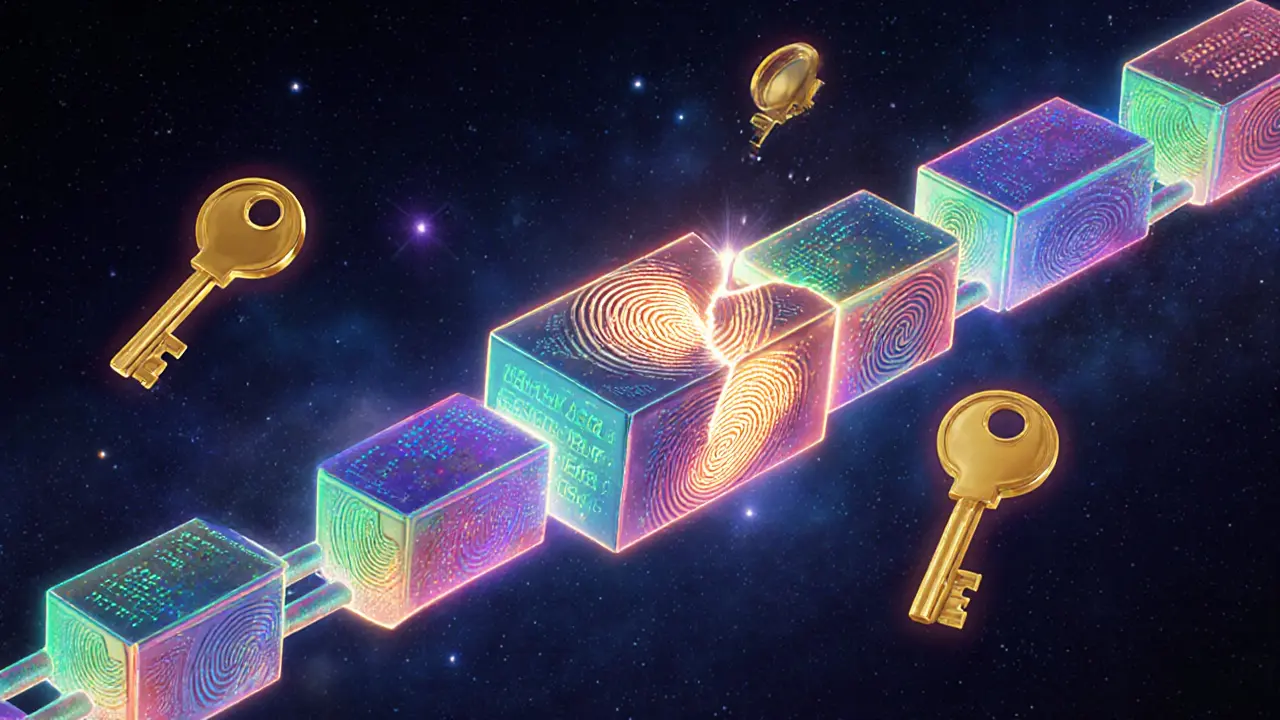Hash Function Visualizer
This tool demonstrates how SHA-256 hashing creates digital fingerprints for blockchain data. Change any character in the input text to see how the hash changes completely.
SHA-256 Output (64 characters)
Avalanche Effect
Small change in input creates completely different hash output.
When you send Bitcoin or use a decentralized app, no bank is watching over your transaction. No middleman is verifying it. So how does the system know it’s real? The answer is cryptographic encryption. It’s the invisible force that makes blockchain secure, trustworthy, and tamper-proof. Without it, blockchain would be just a shared spreadsheet full of lies.
How Cryptographic Encryption Keeps Blockchain Safe
Cryptographic encryption in blockchain isn’t about hiding data like a secret diary. It’s about proving authenticity and stopping anyone from changing what’s already recorded. Think of it like a digital fingerprint that’s impossible to copy or alter without leaving a trace. Every piece of data on a blockchain - whether it’s a Bitcoin transfer, a contract, or a medical record - gets turned into a unique string of characters using a mathematical function called a hash function. Bitcoin uses SHA-256, which turns any input, no matter how big, into a 64-character hash. If you change even one letter in the original data, the hash becomes completely different. That’s how the chain knows something’s been tampered with. Each block in the chain contains the hash of the previous block. So if someone tries to change a transaction from last week, they’d have to recalculate every single hash after that - on every copy of the blockchain across thousands of computers. It’s not just hard. It’s practically impossible with today’s technology.The Three Pillars of Blockchain Encryption
Blockchain encryption relies on three core cryptographic tools working together:- Hash functions - lock data in place and link blocks together.
- Asymmetric cryptography (public/private keys) - proves who owns what.
- Digital signatures - verify that a transaction was approved by the rightful owner.
Why Blockchain Encryption Is Different From Traditional Security
Traditional systems - like banks or cloud servers - rely on centralized control. If a hacker breaks into Amazon’s servers, they can change records, delete logs, or steal data. Blockchain doesn’t have a central point of failure. Data is spread across thousands of nodes, and every change must be cryptographically verified by the network. Also, traditional encryption often uses symmetric keys - one key to lock and unlock. That’s risky because if the key is stolen, everything’s exposed. Blockchain uses asymmetric keys. The public key is shared openly. The private key stays secret. Even if someone sees your public key, they can’t reverse-engineer your private key. Not with today’s computers. This design makes blockchain uniquely suited for trustless environments. You don’t need to know or trust the person you’re transacting with. You just need to trust the math.
What Can Go Wrong? The Real Risks
Despite its strength, blockchain encryption isn’t bulletproof. Most breaches don’t come from cracking SHA-256 or breaking ECC. They come from human error.- Weak key management - Storing private keys on an unsecured phone or writing them on paper in your wallet.
- Phishing scams - Fake websites tricking users into entering their seed phrases.
- Smart contract bugs - Code flaws in decentralized apps that let attackers drain funds, even if the blockchain itself is secure.
Tools Developers Use to Implement Blockchain Encryption
If you’re building on blockchain, you won’t write encryption from scratch. You’ll use well-tested libraries:- OpenSSL - Used for general cryptographic operations, including hashing and key generation.
- Libsodium - A modern, easy-to-use library for secure messaging and key exchange.
- Ethereum’s Web3.js - Handles signing transactions and interacting with the Ethereum blockchain.

What’s Next for Blockchain Encryption?
The future of blockchain security isn’t just about stronger math. It’s about smarter privacy. Zero-knowledge proofs (ZKPs) are one of the biggest advances. They let you prove you know something - like a password or a private key - without revealing it. ZKPs are now used in blockchains like zkSync and Polygon to enable private transactions while still maintaining full verification. This means you can prove you’re eligible for a loan or have enough funds for a purchase without showing your balance. Another trend is integrating blockchain encryption with IoT devices. Imagine a smart fridge that automatically pays for groceries using a crypto wallet. The fridge’s hardware must securely store a private key, and the network must verify its identity without human input. This requires lightweight, efficient crypto that works on low-power chips.Final Thought: Encryption Is the Heart of Blockchain
Blockchain doesn’t create trust. It proves it. And it does that through cryptography. The math behind it is old - hash functions and public-key systems have been around since the 1970s. But putting them together in a decentralized, tamper-proof chain? That’s what Satoshi Nakamoto did in 2008, and it changed everything. Today, blockchain encryption isn’t just for Bitcoin. It’s used in supply chains to track food safety, in voting systems to prevent fraud, and in digital IDs to give people control over their personal data. The core idea remains the same: use math, not middlemen, to secure the truth.Understand the encryption, and you understand blockchain. Skip it, and you’re just following the hype.
Is blockchain encrypted data private?
Most public blockchains like Bitcoin and Ethereum don’t encrypt the actual transaction data - they make it visible to everyone. What’s protected is the ownership and authenticity through digital signatures. If you want privacy, you need to use blockchains with built-in zero-knowledge proofs or mixers. Otherwise, your transaction history is public and traceable.
Can blockchain be hacked?
The blockchain itself - the chain of hashed blocks - has never been hacked. But exchanges, wallets, and smart contracts built on top of it have been. A hacker doesn’t break the encryption; they trick users into giving up their private keys, exploit code bugs, or launch phishing attacks. The system is only as secure as the weakest link - often the person using it.
What’s the difference between hashing and encryption in blockchain?
Hashing turns data into a fixed-size string that can’t be reversed. It’s used to link blocks and verify integrity. Encryption scrambles data so only someone with the key can read it. Blockchain uses hashing to secure the ledger and encryption (via public/private keys) to prove ownership. Hashing doesn’t need a key. Encryption does.
Why does Bitcoin use SHA-256?
SHA-256 was chosen because it’s fast, secure, and produces a consistent 256-bit output no matter the input size. It’s resistant to collisions (two different inputs creating the same hash) and has been vetted by cryptographers for decades. It’s also computationally intensive, which helps secure the network through proof-of-work mining.
Are quantum computers a real threat to blockchain?
Yes, but not yet. Current quantum computers aren’t powerful enough to break ECC or RSA keys used in blockchain. However, researchers estimate that a large-scale quantum computer could do it within 10-20 years. That’s why projects like Ethereum and Polkadot are already exploring quantum-resistant algorithms. SHA-256 hashing is less vulnerable, but key exchange systems need upgrading.
How do I protect my private key?
Never store it on your phone, email, or cloud. Use a hardware wallet like Ledger or Trezor. Write the recovery phrase on paper and keep it in a safe place. Enable multi-signature for large holdings. Never share your private key or seed phrase with anyone - not even someone claiming to be from support.

Michael Faggard
November 12, 2025 AT 04:31Cryptographic encryption in blockchain isn't encryption at all-it's hashing and digital signatures. People keep saying 'encrypted' when they mean 'hashed.' SHA-256 is a one-way function, not encryption. Encryption implies reversibility. This isn't. Stop misleading newcomers.
Public key cryptography? Yes. Asymmetric key signing? Absolutely. But calling it 'encryption' is technically wrong and undermines real crypto literacy.
Wayne Dave Arceo
November 13, 2025 AT 19:07Actually, you're both wrong. Hashing is part of it, but the transaction data itself is not encrypted-it's publicly visible. That's why blockchain isn't 'private.' You're conflating integrity with confidentiality. The blockchain proves ownership, not secrecy. If you think your Bitcoin is 'encrypted,' you don't understand the basics. This is why Americans think they're tech-savvy when they're just repeating buzzwords.
Real encryption? That's AES-256. This? It's a ledger with math.
Michael Heitzer
November 14, 2025 AT 05:21Think about this: blockchain doesn't create trust-it reveals it. The math doesn't lie. The human does.
Hash functions are the fingerprints of reality. Public keys are the names on the door. Digital signatures are the handshake that says, 'I meant this.'
We built systems around trust in people-banks, governments, lawyers. Blockchain says: trust the process. The code. The consensus. The immutable record.
It's not about hiding data. It's about proving truth without permission.
And yes-quantum computing will change everything. But so did the printing press. So did electricity. So did the internet. We adapt. We evolve. The math is older than Bitcoin. The vision? That's the new part.
Don't fear the future. Understand the foundation. Then build.
That’s what Satoshi did. That’s what we must do too.
ty ty
November 15, 2025 AT 04:52Wow. So you're telling me the whole crypto world is just a glorified Excel sheet with a fancy name and a bunch of guys in hoodies pretending they're wizards?
And you paid real money for this?
Good luck with that.
BRYAN CHAGUA
November 15, 2025 AT 22:03This is one of the clearest explanations I've seen on blockchain cryptography. Thank you for breaking down the difference between hashing and encryption-it’s a distinction too many overlook.
The emphasis on human error over algorithmic failure is especially important. Too many blame the technology when the real vulnerability is the person holding the private key.
Also, the mention of zero-knowledge proofs is spot-on. That’s where the next decade of privacy-focused blockchains will live. Not in bigger blocks, but in smarter proofs.
Stephanie Platis
November 16, 2025 AT 04:04Let me be perfectly clear: if you're storing your private key on your phone, you're not just careless-you're reckless. You're literally handing your life savings to every malware developer with a GitHub account.
And don't even get me started on 'seed phrases' written on sticky notes. That's not a backup-it's a suicide note for your wallet.
Hardware wallets aren't optional. They're mandatory. If you can't afford one, don't hold crypto. Period.
And yes-quantum computing is coming. But your negligence? That's already here.
Joy Whitenburg
November 16, 2025 AT 06:34lol i just bought my first btc last week and i have no clue what any of this means but i saved my 12 words on a piece of paper and put it in my sock drawer 😅
is that bad??
also why does everyone sound like they’re giving a TED Talk about my money??
Kylie Stavinoha
November 17, 2025 AT 08:34The elegance of blockchain cryptography lies in its simplicity: trustless verification through mathematical certainty.
It’s not magic. It’s not religion. It’s applied number theory-dating back to Diffie-Hellman and RSA-repurposed for a world without intermediaries.
What’s fascinating is how it mirrors ancient systems of trust: the seal on a clay tablet, the ink signature on parchment, the notary’s stamp. Now, instead of a human witness, we have a distributed network verifying a cryptographic proof.
This is the digital equivalent of the Rosetta Stone-not translating languages, but translating trust into code.
And yet, we still rely on humans to manage the keys. That’s the paradox. The system is flawless. The user? Not so much.
Perhaps the real innovation isn’t the math. It’s the humility it demands: you are not above the system. You are part of it. And your carelessness breaks it.
Diana Dodu
November 18, 2025 AT 09:23China is already building quantum-resistant blockchains. The U.S. is still arguing over whether SHA-256 is 'encryption.' We're falling behind. This isn't just about crypto-it's about national security. If we don't lead in post-quantum cryptography, we lose control of digital sovereignty.
And while you're all debating private keys, Russia and China are minting state-backed digital currencies with embedded surveillance. We're playing checkers while they're playing 4D chess.
Stop treating this like a hobby. This is the future of finance, identity, and power. And we're not ready.
Raymond Day
November 19, 2025 AT 00:20Okay, so let me get this straight-you’re telling me that if I lose my private key, I lose everything… forever?
And there’s NO customer service?
NO ‘I forgot my password’ button?
NO ‘help, I’m being hacked’ hotline?
WHY IS THIS A THING??
Someone please tell me this is a joke. Because if it’s not, then the entire crypto movement is just a glorified Ponzi scheme built on the backs of people who don’t know how to use a USB drive.
And now you want me to trust this with my life savings??
😭
Noriko Yashiro
November 19, 2025 AT 04:50Actually, in the UK, we’ve been using similar cryptographic principles in our national identity system since the 2000s. Blockchain just applies it to finance. The core ideas aren’t new-just the architecture.
And yes, quantum computing is a threat. But the UK’s National Cyber Security Centre has already started testing lattice-based cryptography. We’re ahead of the curve.
Don’t panic. Prepare.
Atheeth Akash
November 19, 2025 AT 14:55very good explanation
hashing is like a fingerprint
private key is like your soul
if you lose it you are gone
no second chances
thank you for this
James Ragin
November 20, 2025 AT 03:29SHA-256 was chosen not because it’s secure-but because it’s slow enough to make mining profitable for early adopters. The whole thing was designed to enrich a small group of tech elites while pretending it’s about decentralization.
Quantum computing? That’s the cover. The real threat is the Federal Reserve and the CIA-they’ve known how to break ECC since the 90s. They’re just waiting for mass adoption before they shut it down.
They’re not afraid of hackers. They’re afraid of people who don’t need banks.
Don’t be fooled. This isn’t freedom. It’s a trap.
Michael Brooks
November 21, 2025 AT 20:26Just want to add something practical: if you're using Web3.js or ethers.js, always check the version. A lot of DeFi apps still use outdated libraries with known vulnerabilities. Even if the crypto is solid, the wrapper code? Not always.
Also, never trust a 'free wallet' app from the App Store. Most of them are just frontends that send your seed phrase to a server somewhere. Use Ledger Live or Trezor Suite-official tools only.
And for the love of god, don't click 'approve' on a random contract unless you know exactly what it does. That's how people lose millions in seconds.
It's not the blockchain that's dangerous. It's the apps built on top of it.
Do your homework. It's not hard. Just take 20 minutes before you sign anything.